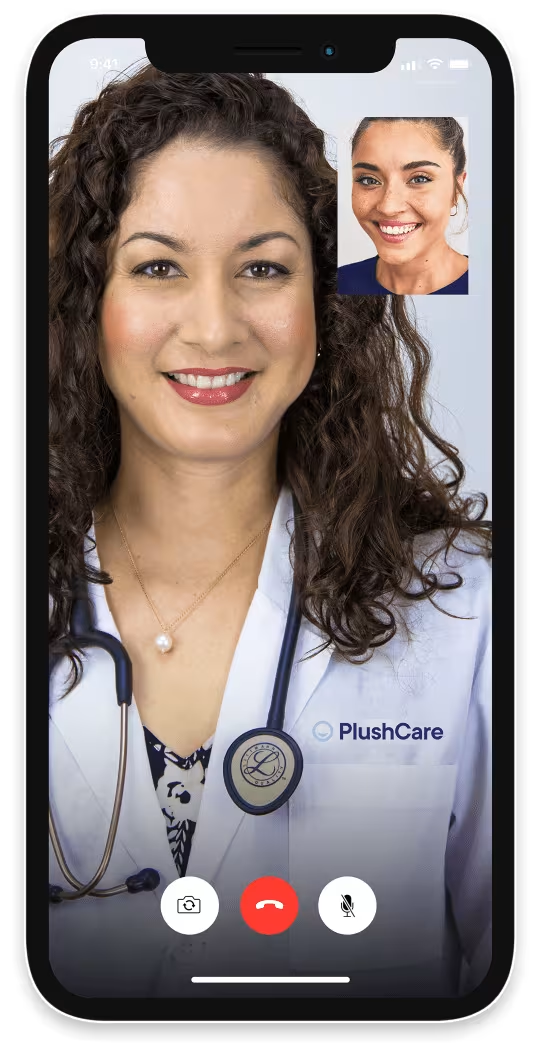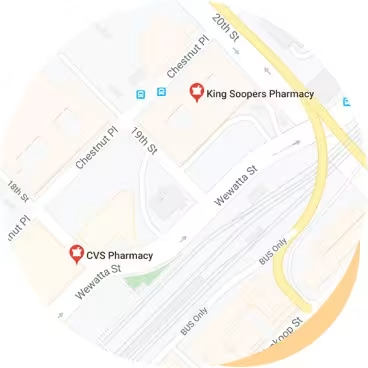- Sexual Health
- STDs
Chlamydia
Online Chlamydia Treatment: Same-Day Prescription Available
With our same-day chlamydia treatment online, you can meet with a top-rated doctor and have your STD treated within minutes. A board-certified PlushCare doctor can order lab testing and prescribe any necessary medication.* Chlamydia is one of the most common STDs in the United States, with about 2-4 million cases annually, and it is often asymptomatic.
Book an appointmentConfidential and discreet virtual appointments
Personalized Chlamydia treatment plans for effective results
Guidance on preventive measures and partner notification
*Prescriptions are provided at the doctor’s discretion. Learn more about our controlled substances policy and how you can save up to 80% with our prescription discount card. PlushCare doctors cannot treat all cases of chlamydia. Our primary care physicians can conduct an initial evaluation of your symptoms but may need to refer you to a specialist or for in-person treatment. If you are experiencing life-threatening symptoms, seek emergency medical attention immediately.

What is chlamydia?
Chlamydia is a sexually transmitted infection (STI) caused by the bacterium Chlamydia trachomatis. It can infect the genital tract, throat, and eyes. Often asymptomatic, it may lead to serious health issues if left untreated. Regular testing and safe sexual practices are crucial for prevention and early detection.
According to the Centers for Disease Control and Prevention (CDC) fact sheet, chlamydia infections are the most frequently reported sexually transmitted diseases in the United States. The CDC fact sheet also states that chlamydia infections can affect both men and women.
You can get a chlamydia trachomatis infection by having any type of sexual intercourse (e.g. vaginal, anal, or oral sex) with someone who has the chlamydia trachomatis bacteria. You can still get a chlamydia infection even if your sexual partner does not ejaculate or penetrate. A chlamydia infection can also cause permanent damage to a woman's reproductive system.
How do you get chlamydia?
Chlamydia trachomatis infections spread through sexual contact, specifically through exchange of bodily fluids (i.e. vaginal fluid or semen) containing the bacteria (chlamydia trachomatis). Sexual contact includes all kinds of sex, including sexual activity that doesn't involve penetration or ejaculation.
Chlamydia is a STD, meaning it is transmitted by having oral, anal, or vaginal sex with a person who already has chlamydia. The infection is spread through semen and vaginal fluids, but the transmission of the disease is not dependent on ejaculation. While the infection comes from these fluids, it can infect the eyes and throat in addition to the vagina, cervix, penis, urethra, and anus. Anyone can get chlamydia, even if they have been diagnosed and treated for chlamydia before. Additionally, women who are pregnant can pass chlamydia onto their baby during birth. This can result in the baby having pneumonia, an eye infection, or even blindness.
Since these fluids are required to transmit the bacteria that causes chlamydia, you cannot get chlamydia through casual contact. For example, it is not possible to get chlamydia from kissing, holding hands, hugging, sneezing, sitting on a toilet, or sharing food.
Certain traits do increase your likelihood of contracting chlamydia:
Engaging with multiple sexual partners in one year – The more partners that you engage with, the more likely you will be exposed to an infected person and contract an STD.
Having unprotected sex – Condoms can reduce the likelihood of you contracting an STD; however, condoms are never 100% effective. If you are concerned you may have an STD, you should get tested regardless of whether you used a condom in your last sexual encounter.
Younger than 24 – Individuals younger than 24 tend to practice unprotected sex more often than other age groups and are less likely to be tested.
Previous diagnosis of an STD – Having already contracted an STD increases your body’s susceptibility to contracting another STD. It can be common for those who have contracted chlamydia to be at risk for contracting gonorrhea or HIV.
What are the symptoms of chlamydia?
Early detection of chlamydia is difficult as it often presents little to no symptoms. However, even without symptoms, chlamydia infections can still cause serious health problems. Symptoms may not appear until several weeks after engaging in sexual activity with a sex partner who has chlamydia.
It is common for someone with chlamydia to have no symptoms. 75% of women and 50% of men with chlamydia exhibit no symptoms. The key signs of chlamydia can appear within one week or up to three weeks after having sex with a partner with chlamydia. Even with no symptoms, it is still possible to transmit the disease and damage the reproductive system.
There are some differences in how chlamydia presents in men vs women. In general, the most commonly reported symptoms in both men and women are:
Chlamydia discharge – For women, this includes abnormal discharge from the vagina that may have a strong odor and be yellowish. For men, this can vary greatly but may see a cloudy or clear discharge around the tip of the penis.
Burning sensation while urinating – Also called dysuria, this symptom is common with other STDs and is an important sign to get tested.
Burning or itching around the vagina or penis – For women, this burning or itching may also be inside the vagina, and for men, this is usually around the penial opening.
Women can also have painful periods, bleeding between periods, pain during sex, abdominal pain, or a fever. Men can also have a less common symptom of swelling or pain in either or both testicles. Chlamydia can spread or infect the anus, causing:
Discharge
Bleeding
Rectal pain
While rare, chlamydia can infect your eyes, cause itching, redness, a discharge, or even your throat, causing soreness.

How to treat chlamydia
Due to the bacterial nature of chlamydial infection, antibiotics are highly effective treatments. Doctors typically place patients on an antibiotics regimen once chlamydia test results confirm a chlamydia diagnosis. The majority of the patients begin to feel better within a week of the antibiotics treatment.
Chlamydia medication
The most commonly prescribed medications to treat chlamydia are:
It's crucial to complete the full course of medication as prescribed, even if symptoms subside, to ensure the infection is completely eradicated. Additionally, individuals with chlamydia should inform their sexual partners, who may also need testing and treatment to prevent reinfection. Regular follow-up testing is advisable to confirm the effectiveness of the treatment.
How to prevent chlamydia
Any sexually active individual has certain risk of catching chlamydia. You're most at risk if you have a new sexual partner or do not practice safe sex. You can help to prevent the spread of chlamydia by using condoms consistently when engaging in sexual activities.
Sexually active young people tend to be at a higher risk of getting chlamydia due to behaviors and biological factors, such as a higher frequency of switching new sexual partners.
Sexually active women younger than 25 years old should get tested for chlamydia every year. Sexually active women 25 years and older should also get tested every year if any of the following risk factors apply:
New sexual partner
Multiple sexual partners
Sex partner with a sexually transmitted infection

When to see a doctor for chlamydia
As soon as you see potential signs of infection that may be related to a chlamydia infection you should make an appointment with a doctor. Untreated chlamydia can put your health at risk.
For a person with a penis, the following issues can arise:
Epididymitis - This infection can spread to the testicles and the epididymis, causing pain and swelling the testicles.
Reduced fertility
Reactive arthritis - This causes swollen joints.
For a person with a vagina, the following issues can arise:
Pelvic inflammatory disease (PID) - This refers to infection of the uterus and fallopian tubes. The infection can cause pelvic pain and fever.
Pregnancy complications
Reactive arthritis - This causes swollen joints.

Gonorrhea and Chlamydia: Understanding the Differences
After chlamydia, gonorrhea is the second most common STD. Gonorrhea, also called the “clap,” is caused by the bacteria Neisseria gonorrhoeae, which produces an infection in the mucus membranes. Like chlamydia, gonorrhea bacteria can grow and infect women in the cervix, uterus, or fallopian tubes and in men, in the urethra. It can also infect the anus, mouth, and throat. Additionally, just like chlamydia, gonorrhea can be passed onto newborns during childbirth if the mother is infected and remains untreated. The same risk factors, like having unprotected sex, having multiple sexual partners in a given time frame, and being between the ages of 14 and 24, apply to gonorrhea.
Once infected, gonorrhea can begin to show symptoms in one to two weeks or even after one month. Gonorrhea, like chlamydia produces very similar symptoms:
Discharge – This discharge can be white or greenish-yellow from the vagina or penis.
Burning sensation while urinating – This occurs in both men and women.
Pain or swollen sexual organs – For men, this originates in the testicles, and for women, this is in the pelvis and vulva.
Similar to chlamydia, gonorrhea can exhibit no symptoms in some people or very mild symptoms. This often leads women to believe they have a yeast infection and self-treat with over-the-counter medication. So, it is important to consult a doctor to make sure you get a proper diagnosis and treatment. Gonorrhea and chlamydia are both diagnosed with a swab of the infected area and treated with antibiotics. These bacterial infections, chlamydia and gonorrhea, can also occur simultaneously, so testing for both is important.
Related conditions to chlamydia
Bacterial vaginosis (BV)
This is a common vaginal condition in women and has been associated with Chlamydia trachomatis.
Gonorrhea
This is also a common sexually transmitted disease that is caused by a bacteria. According to the Centers for Disease Control and Prevention (CDC), similar to chlamydia, an untreated gonorrhea can also cause pelvic inflammatory disease in women
Hepatitis
The hepatitis B virus can be transmitted through sexual activities.
Herpes
This is another sexually transmitted disease but caused by a virus.
HIV/AIDS
According to the Centers for Disease Control and Prevention (CDC), people with chlamydia may be at an increased risk of getting HIV.
Human papillomavirus (HPV)
This is a viral sexually transmitted disease. Several scientific studies have looked into co-infection of chlamydia and HPV, but with mixed results.
Chlamydia treatment FAQs
What is the best way to treat chlamydia?
Antibiotics are highly effective in treating chlamydia. Majority of the patients begin to feel better within a week of the antibiotics treatment. However, to be completely cured of the chlamydia infection, finish the prescribed antibiotics course.
How long can you have chlamydia without knowing?
Early detection of chlamydia is difficult as it often presents little to no symptoms. Symptoms typically present themselves between 1 and 3 weeks after unprotected sex.
What can be the effect of not being treated for chlamydia?
In men, untreated chlamydia can cause pain and swelling in one or both testicles. If detected early, chlamydia may be treated with a single dose of antibiotics. In women, untreated chlamydia infection can develop pelvic inflammatory disease (PID). PID is the infection of the uterus and fallopian tubes, which can cause pelvic pain, fever and infertility.
How long until chlamydia is contagious?
A person can become contagious from the time he/she is infected with chlamydia, and can continue to spread the infection until he/she has completed treatment.
When a person is having chlamydia treated with antibiotics, he/she should abstain from sexual activities for seven days after single dose of azrithromycin or until completion of all seven days of doxycycline.What can be done to prevent the spread of chlamydia?
The best way to prevent chlamydia infection is to abstain from sexual activities. If you are sexually active, use a male latex condom or a female polyurethane condom consistently during each sexual interaction.
Can chlamydia go away on its own?
Without proper antibiotics treatment, it is highly unlikely for chlamydia to go away on its own. Even if the symptoms can recede, the bacteria are still present in the body.
If I am pregnant, will chlamydia affect my baby?
If you are pregnant and have chlamydia, you can pass the infection to your baby during delivery. Chlamydia can cause an eye infection or pneumonia in your newborn. There is a higher chance of premature birth. Therefore, if you are pregnant, you should receive testing for chlamydia at your first prenatal visit. You can make an appointment with a doctor to get tested and treated if necessary.
3 simple steps to request treatment for chlamydia today

Step 1
Book a chlamydia treatment request appointment.
Book a same day appointment from anywhere.

Step 2
Talk to your medical provider regarding your chlamydia symptoms.
Visit with a doctor on your smartphone or computer.

Step 3
Pick up a prescription to treat chlamydia.
We can send prescriptions to any local pharmacy.
Chlamydia treatment pricing details
How pricing works
To request chlamydia treatment and get a new or refill on your prescription, join our monthly membership and get discounted visits.
Paying with insurance
Membership
$16.99/month
First month free
Visits
Copay
30 days of free membership
Same-day appointments 7 days a week
Unlimited messages with your Care Team
Prescription discount card to save up to 80%
Exclusive discounts on lab tests
Free memberships for your family
Cancel anytime
Visit price with insurance
Often the same as an office visit. Most patients with in-network insurance pay $30 or less!
We accept these insurance plans and many more:
Paying without insurance
Membership
$16.99/month
First month free
Visits
$129
30 days of free membership
Same-day appointments 7 days a week
Unlimited messages with your Care Team
Prescription discount card to save up to 80%
Exclusive discounts on lab tests
Free memberships for your family
Cancel anytime
Visit price without insurance
Initial visits are $129.
If we're unable to treat you, we'll provide a full refund.
Frequent sexual health searches
Chlamydia treatment resources
Sources:
PlushCare is dedicated to providing you with accurate and trustworthy health information.
Centers for Disease Control and Prevention (CDC). Chlamydia - CDC Fact Sheet (Detailed Version). Accessed on October 16, 2023 at https://www.cdc.gov/std/chlamydia/stdfact-chlamydia-detailed.htm.
MedlinePlus. Chlamydia Infections. Accessed on October 16, 2023 at https://medlineplus.gov/chlamydiainfections.html.
Mayo Clinic. Chlamydia trachomatis: Symptoms & Causes. Accessed on October 16, 2023 at https://www.mayoclinic.org/diseases-conditions/chlamydia/symptoms-causes/syc-20355349.
Office on Women's Health. Chlamydia. Accessed on October 16, 2023 at https://www.womenshealth.gov/a-z-topics/chlamydia.
PlushCare content is reviewed by MDs, PhDs, NPs, nutritionists, and other healthcare professionals. Learn more about our editorial standards and meet the medical team. The PlushCare site or any linked materials are not intended and should not be construed as medical advice, nor is the information a substitute for professional medical expertise or treatment.